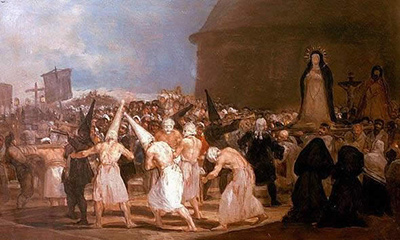A Procession of Flagellants is an oil-on-panel painting from the Romanticism period by the Spanish artist Francisco de Goya. It was created between 1812 and 1819.
Depicted in this scene is a procession of semi-naked, religious zealots wearing pointed hats and whipping their bare backs in the act of penitence. The scene is one of unrestrained cruelty. The backs of the participants are bleeding profusely, and they pull large religious statues, including the Crucifixion of Christ.
Lining the route, are other devotees who are wearing black hoods and kneeling or carrying wooden crosses and lamps. In the dimly-lit background is an indistinct crowd of faithful followers.
A statue of the Virgin Mary is silhouetted against the dark wall of the church.
A Procession of Flagellants is one of a series of paintings by Goya which includes The Bullfight, The Madhouse, and The Inquisition Tribunal. These works portray aspects of Spanish life which Goya, and other liberals tried to reform, but reform was opposed by the absolutist policies of King Ferdinand VII. Flagellation was practised during Holy Week in Spain in the late 18th Century in spite of a ban by the authorities.
Francisco de Goya despised fanaticism, and he has recorded this event as an indictment of this display of public penance. An Inquisition scene also painted by Goya is very similar in that both paintings portray shocking and fanatical scenes in a critical manner. Years later, Goya revisited the subject in a drawing entitled Holy Week in Spain in Times Past.
A Procession of Flagellants can be viewed at the Museo de la Real Academia de San Fernando, Madrid.
Francisco de Goya, the artist, was born in 1746, in Spain. At the age of 14, he trained under the religious painter Jose Luzan. His work involved the copying of stamps, but he soon found this tedious and sought alternative instruction. He moved to Madrid at 18 years of age to undertake a more formal training but without much success. In 1771, he decided to go to Rome where he found success and gained confidence. Goya then returned to Spain and continued studying under Francisco Bayeu y Subias who assisted Goya in his career by finding him work in the Royal Tapestry Factory. This useful experience eventually led to his employment with the Spanish Royal Family in 1786.
Francisco Goya fell seriously ill in 1792, while travelling and withdrew from the court temporarily. The illness left him deaf, and he developed a dark view of Spanish society, which he believed had become foolish and frivolous. One of his well-known works entitled The Sleep of Reason Produces Monsters is a self-portrait of him asleep and surrounded by monsters representing immorality and stupidity. This began a series of works by Goya in the ideals of Romanticism, which was a creative movement at the time, focusing on imagination and emotion. He created a world of witches, monsters and dream-like scenarios to mock the superstitious beliefs of the Spanish people.
In spite of his deafness and the change in the style of his work, Goya was honoured by King Charles IV in 1799, when he was given the position of First Court Painter. He was charged with painting portraits of the nobility in the Spanish Court. One such painting was entitled Charles IV of Spain and His Family, which was commissioned in 1800. Several years later, due to a lack of political stability, Spain was invaded by Napoleon and the French armies. While many Spaniards rebelled against the new king, Joseph I, Goya still accepted commissions from the new monarch.
When Napoleon’s reign ended, the old Spanish king’s son, Ferdinand VII took the throne. He proved to be a tyrannical ruler, reinstating the Inquisition. The new king questioned Goya’s loyalty, and in response to this Goya created two paintings portraying the bloody aftermath of the Spanish riots against the French armies. The Third of May 1808, was one of the paintings and the way Goya composed this painting was quite remarkable. A brightly lit, central religious figure on a dark background. This was not a heroic painting, but instead depicted the Spanish as vulnerable as they resisted the demonic French armies.
In 1824, Francisco Goya went into exile in Bordeaux, where he passed away in 1828. Today, Francisco Goya is regarded as the last of the Old Masters and the first of the Moderns. The bold use of paint, combined with his subversive imagination, influenced many artists of later generations.




